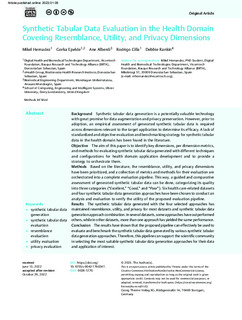Izenburua
Synthetic Tabular Data Evaluation in the Health Domain Covering Resemblance, Utility, and Privacy DimensionsEgilea
Egilea (beste erakunde batekoa)
Beste instituzio
VicomtechUniversity of Ulster
Bertsioa
Bertsio argitaratua
Eskubideak
© 2023 ThiemeSarbidea
Sarbide irekiaArgitaratzailearen bertsioa
https://doi.org/10.1055/s-0042-1760247Non argitaratua
Methods of Information in Medicine Argitaratzailea
ThiemeGako-hitzak
synthetic tabular data generation
synthetic tabular data evaluation
resemblance evaluation
utility evaluation ... [+]
synthetic tabular data evaluation
resemblance evaluation
utility evaluation ... [+]
synthetic tabular data generation
synthetic tabular data evaluation
resemblance evaluation
utility evaluation
privacy evaluation
ODS 3 Salud y bienestar [-]
synthetic tabular data evaluation
resemblance evaluation
utility evaluation
privacy evaluation
ODS 3 Salud y bienestar [-]
Laburpena
Background. Synthetic tabular data generation is a potentially valuable technology with great promise for data augmentation and privacy preservation. However, prior to adoption, an empirical assessmen ... [+]
Background. Synthetic tabular data generation is a potentially valuable technology with great promise for data augmentation and privacy preservation. However, prior to adoption, an empirical assessment of generated synthetic tabular data is required across dimensions relevant to the target application to determine its efficacy. A lack of standardized and objective evaluation and benchmarking strategy for synthetic tabular data in the health domain has been found in the literature.
Objective. The aim of this paper is to identify key dimensions, per dimension metrics, and methods for evaluating synthetic tabular data generated with different techniques and configurations for health domain application development and to provide a strategy to orchestrate them.
Methods. Based on the literature, the resemblance, utility, and privacy dimensions have been prioritized, and a collection of metrics and methods for their evaluation are orchestrated into a complete evaluation pipeline. This way, a guided and comparative assessment of generated synthetic tabular data can be done, categorizing its quality into three categories (“Excellent,” “Good,” and “Poor”). Six health care-related datasets and four synthetic tabular data generation approaches have been chosen to conduct an analysis and evaluation to verify the utility of the proposed evaluation pipeline.
Results. The synthetic tabular data generated with the four selected approaches has maintained resemblance, utility, and privacy for most datasets and synthetic tabular data generation approach combination. In several datasets, some approaches have outperformed others, while in other datasets, more than one approach has yielded the same performance.
Conclusion. The results have shown that the proposed pipeline can effectively be used to evaluate and benchmark the synthetic tabular data generated by various synthetic tabular data generation approaches. Therefore, this pipeline can support the scientific community in selecting the most suitable synthetic tabular data generation approaches for their data and application of interest. [-]
Sponsorship
Gobierno Vasco-Eusko JaurlaritzaProjectu ID
Emaitek Plus ActionBildumak
Item honek honako baimen-fitxategi hauek dauzka asoziatuta:
Bestelakorik adierazi ezean, itemaren baimena horrela deskribatzen da: Attribution-NonCommercial-NoDerivatives 4.0 International
Related items
Showing items related by title, author, creator and subject.
-
Ultrasound image processing in the evaluation of labor induction failure risk
Vasquez Obando, Pablo Jose (Mondragon Unibertsitatea. Goi Eskola Politeknikoa, 2017)Labor induction is defined as the artificial stimulation of uterine contractions for the purpose of vaginal birth. Induction is prescribed for medical and elective reasons. Success in labor induction procedures is related ... -
Evaluation of 5G Modulation Candidates WCP-COQAM, GFDM-OQAM, and FBMC-OQAM in Low-Band Highly Dispersive Wireless Channels
Lizeaga, Aitor; Mendicute, Mikel (Hindawi, 2017)We analyse some of the candidates for modulations for 5G: FBMC-OQAM, GFDM-OQAM, and WCP-COQAM. Unlike most of the related bibliographies, which are oriented to mobile communications, our research is focused on 5G in cognitive ... -
Evaluation of the frequency response of AC transmission based offshore wind farms
Abad, Gonzalo; Barrena, Jon Andoni (InTech Europe, 2011)






















